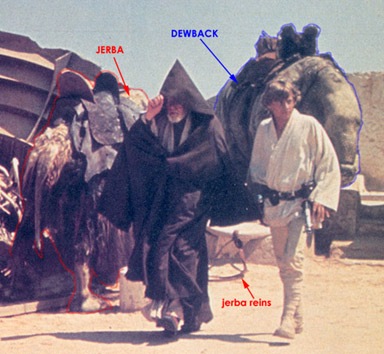Dewbacks are reputedly solitary reptiles [according to printed sources in the 1990s] native to the planet Tatooine. However during the occupation of Naboo [TPM] a herd of dewbacks was seen together near Queen Amidala's royal yacht on the outskirts of Mos Espa. Dewbacks grow to approximately five metres long and two metres high. They are generally covered in smooth hexagonal scales. A finely tufted mane of pale fur grows along the spine from the crest of the neck to somewhere near the rump. The species' common name “dewback” refers to this hair. The hue of dewback hides varies, but olive-green, brown and possibly beige (judging by dried hides) are known.
A dewback's exceptional shyness and docility in comparison to its size and strength makes this an ideal species for use as desert stead or beast of burden. However the domestication of the dewback is not as advanced as some other riding beasts of the galaxy: they are sometimes unruly, snuffling and sniffing at bystanders when a tamer creature would keep its attention to itself. Dewbacks instinctively go into the wild, deep desert to mate, which is not conducive to systematic breeding programs.
Many dewbacks have a mouth with horny lips protruding from the general contour of the snout, and a tough, horny beak at the front. Some dewbacks sport an apparently stiff, upright frill at the back of the head. The biological functions of these structures — and whether they are related to species, gender, season or age — remains unknown at this time.
The dewback lacks any obviously distinct ear on its head, so the acuity of its hearing is unknown. The nostrils are considerably larger than the eyes, implying that the beasts' sense of smell is more important than its eyesight. The eyes are positioned on the flat sides of the head, providing a wide field of view at the expense of forward stereoscopic vision. This configuration indicates that the dewback is a passive herbivore that must remain alert for predators.
Also see:


 Stormtrooper astride a dewback on Tatooine [model on location: 1978 lobby card (Bonhams auction site); Star Wars Chronicles; Star Wars Technical Journal #1].
Stormtrooper astride a dewback on Tatooine [model on location: 1978 lobby card (Bonhams auction site); Star Wars Chronicles; Star Wars Technical Journal #1].
 A dewback and a jerba, leashed outside a cantina in Mos Eisley. [Star Wars Technical Journal #1]
A dewback and a jerba, leashed outside a cantina in Mos Eisley. [Star Wars Technical Journal #1]









 Imperial stormtroopers rode Tatooine dewbacks in their search for the stolen Death Star schematics. Interestingly, this dewback has thinner legs, wider head and less pronounced beak than some dewbacks. This may be a different species.
Imperial stormtroopers rode Tatooine dewbacks in their search for the stolen Death Star schematics. Interestingly, this dewback has thinner legs, wider head and less pronounced beak than some dewbacks. This may be a different species.
 The dewback card from the Special Edition series of SWCCG. This is the beakless, fat-headed dewback.
The dewback card from the Special Edition series of SWCCG. This is the beakless, fat-headed dewback.
The old West End Games roleplaying game gave the following statistics for a dewback. The daytime running speed of 100km/h is remarkable. Is this anatomically and biomechanically plausible?
Dexterity 3D
Perception 2D
Strength 4D
Brawling 4D+1
Move: 35; 100 km/h (during day); 7, 20km/h (at night)
Orneriness: 3D
This page was constructed and is maintained by
Curtis Saxton.
This page is neither affiliated with nor endorsed by Lucasfilm Ltd.
Images included in or linked from this page are copyright Lucasfilm Ltd. and are used here under Fair Usage terms of copyright law.
This site is kindly hosted by TheForce.net.